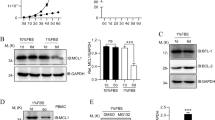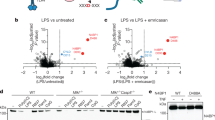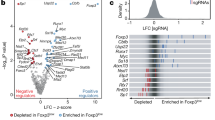Abstract
Programmed cell death is a process required for the normal development of an organism. One of the best understood apoptotic pathways occurs in T lymphocytes and is mediated by Fas/Fas ligand (FasL) interaction. During studies of apoptosis induced by T cell-receptor engagement, we identified ALG-4F , a truncated transcript that prevents T cell-receptor-induced FasL upregulation and cell death. Overexpression of full-length ALG-4 induced transcription of FasL and, consequently, apoptosis. These results indicate that ALG-4 is necessary and sufficient for FasL expression. Fas/FasL interaction initiates cell death in many other systems, and its dysregulation is a mechanism by which several pathologic conditions arise. Understanding the molecular mechanisms of FasL regulation could be very useful in elucidating how these diseases develop and in identifying potential therapeutic targets.
This is a preview of subscription content, access via your institution
Access options
Subscribe to this journal
Receive 12 print issues and online access
$209.00 per year
only $17.42 per issue
Buy this article
- Purchase on Springer Link
- Instant access to full article PDF
Prices may be subject to local taxes which are calculated during checkout





Similar content being viewed by others
References
Kerr, J.F.R., Wyllie, A.H. & Currie, A.R. Apoptosis: a basic biologic phenomenon with wide-ranging implications in tissue kinetics. Br. J. Cancer 26, 239–257 (1972).
Kappler, J.W., Rohem, N. & Marrack, P. T cell tolerance by clonal elimination in the thymus. Cell 49, 273–280 (1987).
Webb, S., Morris, C. & Sprent, J. Extrathymic tolerance of mature T cells: clonal elimination as a consequence of immunity. Cell 63, 1249 –1256 (1990).
Lenardo, M.J. Interleukin-2 programs mouse T lymphocytes for apoptosis. Nature 353, 858–861 ( 1991).
Dhein, J., Walczack, H., Baumler, C., Debatin, K-M. & Krammer, P.H. Autocrine T-cell suicide mediated by APO-1/(Fas/CD95). Nature 373, 438–444 (1995).
Brunner, T. et al. Cell-autonomous Fas (CD95)/Fas-ligand interaction mediates activation-induced apoptosis in T-cell hybridomas. Nature 373, 441–444 (1995).
Ju, S-T. et al. Fas (CD95)/FasL interactions required for programmed cell death after T-cell activation. Nature 373, 444 –448 (1995).
Wong, B. & Choi, Y. Pathways leading to cell death in T cells. Curr. Opin. Immunol. 9, 358– 364 (1997).
Boldin, M.P., Goncharov, T.M., Goltsev, Y.V. & Wallach, D. Involvement of MACH, a novel MORT1/FADD-interacting protease, in Fas/APO-1- and TNF receptor-induced cell death. Cell 85, 803–816 (1996).
Muzio, M. et al. FLICE, a novel FADD-homologous ICE/CED-3-like protease, is recruited to the CD95 (Fas/APO-1) death inducing signaling complex. Cell 85, 817–829 ( 1996).
Kischkel, F.C. et al. Cytotoxicity-dependent Apo-1(Fas/CD95)-associated proteins (CAP) form a death-inducing signaling complex (DISC) with the receptor. EMBO J. 14, 5579–5588 ( 1995).
Chinnayan, A.M. et al. Molecular ordering of the cell death pathway. J. Biol. Chem. 271, 4573–4577 (1996).
Enari, M., Talanian, R.V., Wong, W.W. & Nagata, S. Sequential activation of ICE-like and CPP32-like proteases during Fas-mediated apoptosis. Nature 380, 723– 726 (1996).
Cohen, P.L. & Eisenberg, R.A. Lpr and gld: single gene models of systemic autoimmunity and lymphoproliferative disease. Annu. Rev. Immunol. 9, 243–269 (1991).
Fisher, G.H. et al. Dominant interfering Fas gene mutations impair apoptosis in a human autoimmune lymphoproliferative syndrome. Cell 81, 935–946 (1995).
Rieux-Laucat, F. et al. Mutation in Fas associated with human lymphoproliferative syndrome and autoimmunity. Science 268, 1347–1349 (1995).
Hahne, M. et al. Melanoma cell expression of Fas (Apo1/CD95) ligand: implications for tumor immune response. Science 274, 1363–1366 (1996).
Strand, S. et al. Lymphocyte apoptosis induced by CD95 (APO-1/Fas) ligand-expressing tumor cells. A mechanism of immune evasion? Nature Med. 2, 1361–1366 (1996).
O'Connell, J., O'Sullivan, G. C., Collins, J. K. & Shanahan, F. The Fas counterattack: Fas mediated T cell killing by colon cancer cells expressing Fas ligand. J. Exp. Med. 184, 1075– 1082 (1996).
Bellgrau, D. et al. A role for CD95 ligand in preventing graft rejection. Nature 377, 630–632 ( 1995).
Griffith, T.S. et al. Fas ligand-induced apoptosis as a mechanism of immune privilege. Science 270, 1189–1192 (1995).
Kasibhatla, S. et al. DNA damaging agents induce expression of Fas ligand and subsequent apoptosis in T lymphocytes via the activation of NF-κB and AP-1. Mol. Cell 1, 543–551 ( 1998).
Caricchio, R., Reap, E. A. & Cohen, P. L. Fas/Fas ligand interactions are involved in ultraviolet-B-induced human lymphocytes apoptosis. J. Immunol. 161, 241–251 (1998).
Bennett M. et al. Cell surface trafficking of Fas: a rapid mechanism of p53-mediated apoptosis. Science 282, 290– 294 (1998).
Herr, I. et al. Activation of CD95 (Apo1/Fas) signaling by ceramide mediates cancer therapy-induced apoptosis. EMBO J. 16, 6200–6208 (1997).
Vito, P., Lacana', E. & D'Adamio, L. Interfering with apoptosis: Ca++-binding protein ALG-2 and Alzheimer's disease gene ALG-3. Science 271, 521–525 ( 1996).
D'Adamio, L., Lacana', E. & Vito, P. Functional cloning of genes involved in T-cell receptor-induced programmed cell death. Semin. Immunol. 9, 17–23 (1997).
Nagase, T. et al. Prediction of the coding sequences of unidentified human genes. V. The coding sequences of 40 new genes (KIAA0161-KIAA0200) deduced by analysis of cDNA clones from human cell line KG-1. DNA Res. 3, 17–24 (1996).
Lazebnik, Y.A., Kaufmann, S. H., Desnoyers, S., Poirier, G.G. & Earnshaw, W.C. Cleavage of poly(ADP-ribose) polymerase by a proteinase with properties like ICE. Nature 371, 346–349 (1994).
Tewari, M. et al. Yama/CPP32β, a mammalian homolog of Ced-3, is a CrmA-inhibitable protease that cleaves the death substrate poly(ADP-ribose) polymerase. Cell 81, 801–812 ( 1995).
Latinis, K.M. et al. Regulation of CD95 (Fas) ligand expression by TCR mediated signaling events. J. Immunol. 158, 4602– 4611 (1997).
Matsui, K., Fine, A., Bangmin, Z., Marshak-Rothstein, A. & Ju, S. Identification of two NF-κB binding sites in mouse CD95 ligand (Fas ligand) promoter: functional analysis in T cell hybridoma. J. Immunol. 161, 3469– 3473 (1998).
Baeuerle, P. A. & Henkel, T. Function and activation of NF-κB in the immune system. Annu. Rev. Immunol. 12, 141–179 (1994).
Nagata, S. & Golstein, P. The Fas death factor. Science 267, 1449–1456 ( 1995).
Yang, Y., Liu, Z. H., Ware, C. F. & Ashwell, J. D. A cysteine protease inhibitor prevents activation-induced T-cell apoptosis and death of peripheral blood cells from human immunodeficiency virus-infected individuals by inhibiting upregulation of Fas ligand. Blood 89, 550–557 (1997).
Nagata, S. Fas ligand and immune evasion. Nature Med. 2, 1306–1307 (1996).
D'Adamio, F. et al. A new dexamethasone-induced gene of the leucine zipper family protects T lymphocytes from TCR/CD3-activated cell death. Immunity 7, 803–812 ( 1997).
Ivanov, V.N., Lee, R.K., Podack, E.R. & Malek, T.R. Regulation of Fas-dependent activation-induced T cell apoptosis by cAMP signaling: a potential role for transcription factor NF-κB. Oncogene 14, 2455–2464 (1997).
Bauer, M.K.A. et al. Role of reactive oxygen intermediates in activation-induced CD95 (APO-1/Fas) ligand expression. J. Biol. Chem. 273, 8048–8055 (1998).
Mittelstadt, P. R. & Ashwell, J. D. Cyclosporin A-sensitive transcription factor Egr-3 regulates Fas ligand expression. Mol. Cell. Biol. 18, 3744–3751 (1998).
Nicoletti, I. et al. A rapid and simple method for measuring thymocytes apoptosis by propidium iodide staining and flow cytometry. J. Immunol. Methods 139, 271–279 ( 1991).
Ausubel, F.M. et al. in Current Protocols in Molecular Biology (J. Wiley & Sons, New York, 1992).
Laemmli, U.K. Cleavage of structural proteins during the assembly of the head of bacteriophage T4. Nature 227, 680–685 (1970).
Bours, V. et al. A novel mitogen-inducible gene product related to p50/p105-NF-kappa B participates in transactivation through a κB site. Mol. Cell. Biol. 12, 685–695 (1992).
Hann, S.R. et al. A non-AUG translational initiation in c-myc exon 1 generates an N-terminally distinct protein whose synthesis is disrupted in Burkitt's lymphomas. Cell 52, 185– 195 (1988).
Lacana' E., Ganjei, J. K., Vito, P. & D'Adamio, L. Dissociation of apoptosis and activation of IL-1β-converting enzyme/Ced-3 protease by ALG-2 and the truncated Alzheimer's gene ALG-3. J. Immunol. 158, 5129–5135 (1997).
Acknowledgements
We thank T. Nagase and N. Nomura for the cDNA for human ALG-4; S.-T. Ju for the FasL reporter construct; G. Ruberti for the FasL cDNA; and M.J. Lenardo for the NF-AT and NF-κB reporter vectors. We thank F. Flomerfelt, T. Kristie and R. Schwartz for suggestions and critical reading of the manuscript, and B. Marshall for editorial assistance. E.L. is supported by a Telethon Italy fellowship grant.
Author information
Authors and Affiliations
Corresponding author
Rights and permissions
About this article
Cite this article
Lacana', E., D'Adamio, L. Regulation of Fas ligand expression and cell death by apoptosis-linked gene 4. Nat Med 5, 542–547 (1999). https://doi.org/10.1038/8420
Received:
Accepted:
Issue Date:
DOI: https://doi.org/10.1038/8420



